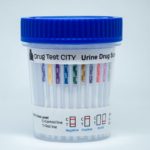
The cutoff level for urine in drug tests is 50ng/ml. Regular smokers will have significantly higher levels of THC. A level of 300ng/ml is considered to be a high level of THC in urine.
The THC level itself isn’t necessarily indicative of high levels of consumption. By drinking water a user of marijuana can cut the level of THC in their urine in half, and have it test in a higher range the very next day. For this reason drug test technicians look at the ratio of THC to creatinine to determine if the level of THC in a user’s urine is decreasing. A ratio of 2.5 to 1 (THC to creatinine) is considered high.
THC levels in drug tests are increasing in line with the potency of cannabis. National Institute of Drug Abuse data shows that the potency of cannabis is increasing steadily since the 1990s.
Quantitative vs. Qualitative Drug testing
It’s important to understand that in most drug tests a high level of THC does not matter. In a quantitative drug test, like 12 panel urine test cups, the sample is either pass or fail. Any urine with more than 50ng/ml is considered a fail and urine with under 50ng/ml is a pass.
Drug tests for probation, court, rehabs, and medical prescriptions are almost always quantitative drug tests that do not provide the actual level of metabolite.
Qualitative drug tests that accurately indicate the levels of THC are mostly used for medical diagnosis and autopsy.
Importance of Measuring THC in Urine
The measurement of THC (Tetrahydrocannabinol) levels in urine is a common practice used in various fields. THC is the main psychoactive compound found in marijuana and is the primary cause of its mind-altering effects. Understanding the importance of measuring THC in urine can provide valuable insights into drug usage, particularly in scenarios such as pre-employment screenings, medical examinations, and rehabilitation programs.
Medical and Legal Significance
The measurement of THC levels in urine is sometimes crucial for both medical and legal reasons. Medical professionals sometimes require this information to assess the frequency and extent of marijuana use in patients. Such evaluations can aid in determining the effectiveness of medical treatments, assessing potential drug interactions, and monitoring patient compliance with prescribed medications.
From a legal standpoint, the measurement of THC in urine is frequently conducted to fulfill workplace drug testing requirements. Many companies enforce drug-free policies to ensure a safe and productive working environment. By measuring THC levels, employers can identify individuals who may be impaired while on the job, promoting a risk-free workplace.
Furthermore, this measurement is essential for law enforcement agencies during investigations involving cannabis-related offenses. Detecting the presence of THC in urine can be used as evidence in court, supporting charges against individuals suspected of driving under the influence of marijuana or other related offenses.
Duration of Marijuana Use Detection
The presence of THC metabolites in urine provides an indication of the recent use of marijuana. However, it is important to note that the detection time frame may vary depending on several factors, including the individual’s metabolism, frequency of drug use, and potency of the marijuana consumed.
Typically, THC metabolites can be detected in urine within 2-5 hours after consumption and remain detectable for up to 3-30 days after usage. Chronic marijuana users may exhibit traces of THC in their urine for an extended period compared to sporadic or first-time users.
Urine Testing Methods
Various methods are available for accurately measuring THC levels in urine:
1.Point of Care Drug Testing- Point of care drug testing only provides a pass or fail result. It let’s you know if the concentration of THC is more or less than 50ng/ml.
2. Gas Chromatography-Mass Spectrometry (GC-MS): Considered the gold standard for THC detection, this technique provides precise and reliable results. GC-MS separates and analyzes the compounds present in urine samples. It can detect even minimal amounts of THC and its metabolites, ensuring accurate measurements.
3. Immunoassay Screening: Immunoassay tests are widely used due to their convenience and cost-effectiveness. These tests provide rapid results and are suitable for initial screenings. However, they may have a higher chance of false positives, and further confirmation through GC-MS testing is often required for accurate measurements.
Factors Affecting THC Levels in Urine
Several factors can influence THC levels in urine, leading to variations in test results:
1. Frequency of Use: Individuals who use marijuana regularly or daily are more likely to have higher THC levels in their urine compared to occasional users.
2. Body Fat Percentage: THC is highly lipophilic, meaning it binds to fat cells in the body. Consequently, individuals with a higher body fat percentage may retain THC metabolites in their system for a longer duration than those with lower body fat.
3. Hydration Levels: Dilution of urine through high water intake can potentially reduce THC metabolite concentrations. However, laboratories often check for urine dilution and may request an additional sample if suspicions arise.
4. Metabolism: A faster metabolic rate can aid in the faster elimination of THC metabolites from the body, leading to lower detection times in urine.
The Importance of Accurate Measurements
Accurate measurement of THC levels is critical to ensure reliable results. Inaccurate measurements can lead to false positives or false negatives, which can have significant repercussions.
For instance, false positives may unfairly incriminate individuals who have not consumed marijuana, potentially damaging their job prospects or reputation. On the other hand, false negatives may dismiss individuals who have, in fact, used marijuana, leading to safety concerns or ineffective medical treatments.
Conclusion
The measurement of THC levels in urine plays a crucial role in various fields, including medicine, law enforcement, and workplace regulations. It provides valuable information about an individual’s marijuana usage, helping medical professionals assess treatments, employers maintain a safe work environment, and legal authorities enforce drug-related laws.
Understanding the factors influencing THC levels in urine and utilizing accurate measurement methods ensures reliable results, preventing potential errors and ensuring fair outcomes.

